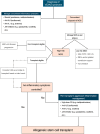VEXAS syndrome: is it more a matter of inflammation or hematopoietic clonality? A case series approach to diagnosis, therapeutic strategies and transplant management
- PMID: 39820409
- PMCID: PMC11868253
- DOI: 10.1007/s00277-025-06207-2
VEXAS syndrome: is it more a matter of inflammation or hematopoietic clonality? A case series approach to diagnosis, therapeutic strategies and transplant management
Abstract
VEXAS syndrome is a complex hemato-inflammatory disorder, driven by somatic mutations in the UBA1 gene within hematopoietic precursor cells. It is characterized by systemic inflammation, rheumatological manifestations, and frequent association with myelodysplastic syndrome (MDS). We present a series of four VEXAS cases, all of which include concomitant MDS, each displaying distinct genetic signatures and clinical features at diagnosis, with a focus on their diagnostic and therapeutic implications. Our findings underscore the importance of extending UBA1 sequencing beyond exon 3 in cases with strong clinical suspicion. Given the rarity of non-canonical variants and the limited gene annotation, germline tissue control should be considered to differentiate somatic from germline mutations. Hematological management, including considerations for transplantation, was primarily guided by the Revised International Prognostic Scoring System (IPSS-R) for MDS due to the absence of a specific risk stratification system for VEXAS or therapy guidelines. A critical point of our discussion is the role of inflammation in the peri-transplant period; in one patient, the combination of disease-modifying antirheumatic drugs (DMARDs) and high-dose corticosteroids before transplant was crucial in controlling inflammation, resulting in a successful hematopoietic stem cell transplantation (HSCT). In contrast, uncontrolled inflammation contributed to the peri-transplant death of another patient. These cases highlight the importance of effective inflammation management in optimizing HSCT outcomes. Additionally, our study emphasizes the urgent need for specific management guidelines for VEXAS syndrome, including a comprehensive risk stratification system and optimal timing for transplantation.
Keywords: Exon 14; Hematopoietic cell transplant; Inflammation; UBA1; VEXAS syndrome.
© 2025. The Author(s).
Conflict of interest statement
Declarations. Ethics and Consent to publish declarations: All procedures in this study were conducted in accordance with the ethical standards of the local Institutional review board and principles of the Declaration of Helsinki. Competing interests: The authors declare no competing interests.
Figures




References
-
- Gurnari C, Pascale MR, Vitale A et al (2024) Diagnostic capabilities, clinical features, and longitudinal clonal dynamics of a nationwide VEXAS cohort. Am J Hematol 99(2):254–262. 10.1002/ajh.27169 - PubMed
Publication types
MeSH terms
Substances
Supplementary concepts
LinkOut - more resources
Full Text Sources
Medical
Research Materials
Miscellaneous

